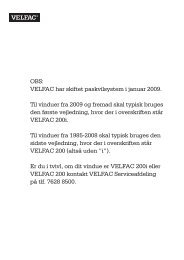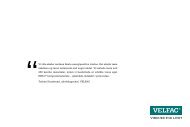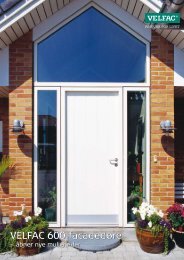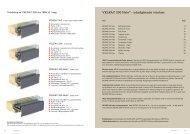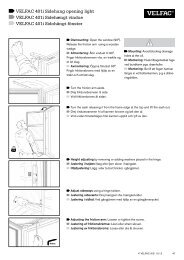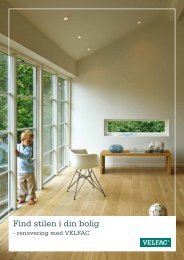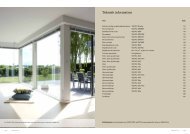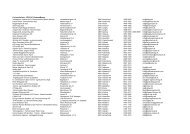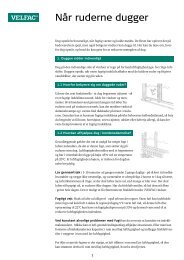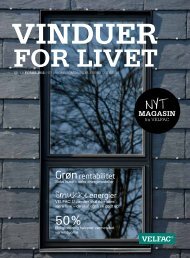Create successful ePaper yourself
Turn your PDF publications into a flip-book with our unique Google optimized e-Paper software.
Plenty of natural daylight, fresh air and good materials<br />
ensure that the house is healthy and comfortable to live in<br />
Comfort<br />
The house of the future shall be pleasant to live in and around. It must not be too warm in the summer<br />
and not too cold in the winter. It should be flexible so that it gives space for both togetherness and for<br />
peace and quiet. And it should be easy to maintain and use.<br />
Ventilation<br />
There is a lot of fresh air in Home for Life. In the winter the air enters in via the mechanical ventilation<br />
system that at the same time ensures that the warmth from the exhaust is reused. The equipment is<br />
programmed so that it adapts to the ventilation needs in the room. The air is circulated into the »clean«<br />
rooms (bedrooms and living rooms) and exhausted from the utility rooms (kitchen, bathroom, laundry<br />
room).<br />
In the summer fresh air enters through natural ventilation that is controlled by a sensor in the house so<br />
that it is not ventilated more than necessary and at the same time, maintains a good indoor climate. The<br />
natural ventilation replaces the mechanical system with the result of energy savings.<br />
Natural ventilation regulates the indoor climate of the building with the help of controlled air exchange<br />
through the windows in the facade and the roof. This is done by using the natural power that is created<br />
by the temperature difference between inside and outside, the thermal lift in the building together with<br />
the wind around the building. The ventilation takes place by a control opening and closing of the windows<br />
depending on the outdoor and indoor climate together with the need for fresh air.<br />
Draught in connection with the air inflow from the mechanical ventilation equipment is avoided by intake<br />
with slow air flow in the residential areas. The ventilation system has built-in heating surfaces to avoid<br />
the intake of unintended cold air. The air intake for the natural ventilation is placed at a height to ensure<br />
the incoming air can be mixed with the room air before it reaches the living area.<br />
Room heating and cooling<br />
The temperature in each room can be regulated independently so it adjusts to the activities in the room.<br />
The house can shield itself from the sun in the summer time, so it is not getting too warm indoors. The<br />
screening is designed to fit the conditions of the facade and its orientation; and is automatically regulated<br />
in such a way that the inside temperature remains stable.<br />
Home for Life is designed to make use of as much passive energy as possible. Passive energy in the<br />
form of high daylight levels, passive heat from the sun together with ventilation via thermal lift and wind<br />
The active facade<br />
In Home for Life comfort is obtained by the help of an active facade.<br />
An active facade:<br />
Regulates itself how much light and warmth comes in through the windows.<br />
Airs out itself, so there is always a healthy indoor climate in the house.<br />
The active facade changes according to the seasons and needs. It can either<br />
be open to let the light and warmth in, or it can be closed to screen against<br />
the sun and maintain warmth during the night.<br />
influence on the facades.<br />
Jan Feb Mar Apr May Jun Jul Aug Sep Oct Nov Dec<br />
16 17<br />
Intake in MWh/month Intake in MWh/month<br />
Intake in MWh/month Intake in MWh/month<br />
3<br />
2,5<br />
32<br />
2,5 1,5<br />
21<br />
1,5 0,5<br />
10<br />
0,5<br />
0<br />
3<br />
2,5<br />
32<br />
2,5 1,5<br />
21<br />
1,5 0,5<br />
10<br />
0,5<br />
0<br />
The Home for Life sun incidence and heat loss<br />
Heat loss<br />
Sun incidence<br />
The Home for Life sun incidence and heat loss Quantity of sun that is screened<br />
Heat loss<br />
Sun incidence<br />
Jan Feb Mar Apr May Jun Jul Aug Sep Oct Nov Dec<br />
Traditional single-family house sun incidence and heat loss<br />
Heat loss<br />
Sun incidence<br />
Traditional single-family house sun incidence and heat loss<br />
Quantity of sun that is screened<br />
Jan Feb Mar Apr May Jun Jul Aug Sep Oct Nov Dec<br />
Heat loss<br />
Sun incidence<br />
Jan Feb Mar Apr May Jun Jul Aug Sep Oct Nov Dec




